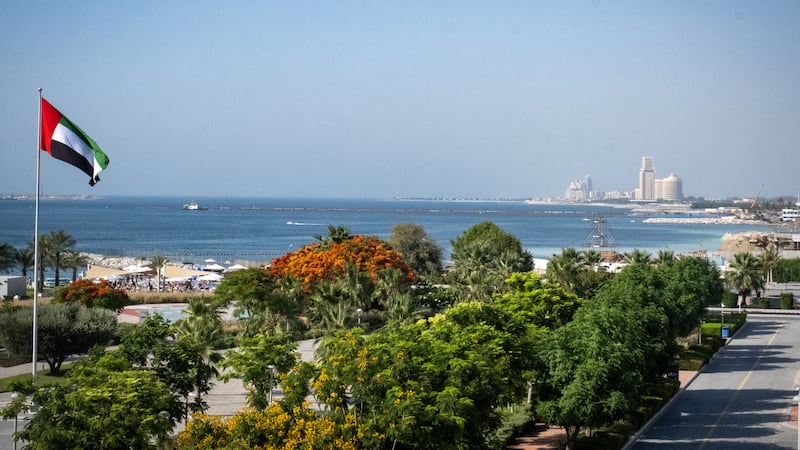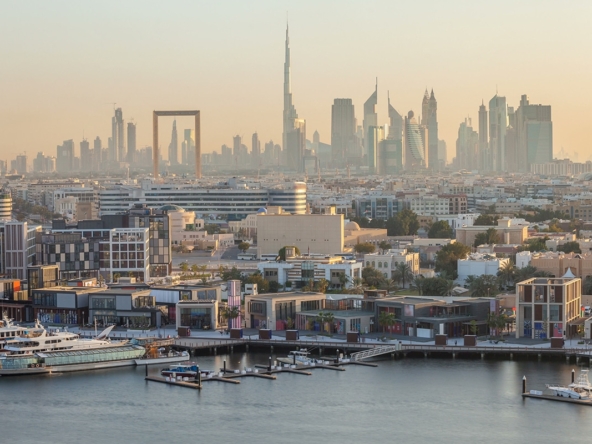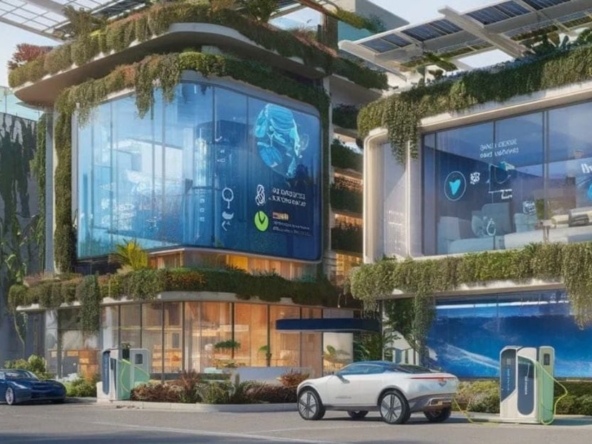Ras Al Khaimah is aiming to attract more people to live and work in the emirate as its economy grows amid a property and tourism boom.
Buyers are investing in property in Ras Al Khaimah as its tourism potential increases with new projects and prices lower than Dubai.
Charu Bjuvestig, who moved to Dubai from London last year, shifted base to Ras Al Khaimah three months ago. She and her husband Peter invested in a property in RAK’s Mina Al Arab development.
“We are very happy with our investment and home, and we definitely see RAK as our home for the near future,” says Ms Bjuvestig.
“We have now been in the UAE for just over a year and we were in Dubai for most of that time. We love it here and decided we wanted to put down a bit more roots and buy a place of our own. While we loved the Dubai Marina area, where we were renting an apartment, and would have to ideally liked to buy there, the price point was way over our budget.”
In the second quarter, apartment prices in Dubai Marina ranged between Dh700 ($190.50) and Dh4,200 per square foot. In contrast, apartment sale prices in RAK’s Mina Al Arab were between Dh475 and Dh1,500 per square foot, according to data from Asteco.
“There definitely is a booming real estate market and it’s very cosmopolitan in some of the areas. Our building has Emiratis, Egyptians, Indians, Britons and, also, a German,” Ms Bjuvestig, an American originally from India, says.
The $3.9 billion Wynn Al Marjan Island, being developed by Las Vegas-based hotel operator Wynn Resorts, is expected to boost the tourism potential of the emirate and is attracting more investment in property in Ras Al Khaimah.
The 1,500-room resort, with entertainment and gaming amenities, is set to open in early 2027.
With Wynn Resorts “coming up in Al Marjan Island as well as multiple resorts up and running in Al Hamra and Mina Al Arab areas, it’s a sweet spot for tourists, Dubai residents looking for a staycation as well as people looking to buy their own dream home”, Ms Bjuvestig says.
A faster commute from Dubai is also a positive factor for people looking to settle down in the northern emirate. “The commute to Dubai is just under an hour door to door, which makes it very easy for us to get to Dubai often to see friends, or have a meal, watch a show. So, we look at RAK almost like another suburb of Dubai,” adds Ms Bjuvestig.
RAK was named fourth-best place to live in the InterNations annual Expat City Ranking 2023, excelling in five categories: quality of life, ease of settling in, working abroad, personal finance and an expatriate essentials index, which covers digital life, administration topics, housing and language.
The emirate is also taking up new initiatives to support education. It established a Ras Al Khaimah Department of Knowledge last year to regulate the sector and ensure students receive quality education.

Over the next few years, the emirate is poised to significantly climb the liveability index. The northern emirate has a population of 400,000, according to the Ras Al Khaimah government media office.
A new digital platform, Heart of Rak, has been unveiled to provide comprehensive information on what is on offer for people who are planning to live and work in the emirate.
“With ongoing investments in infrastructure, education, health care and cultural offerings, I believe Ras Al Khaimah will continue its upward trajectory in regional and international rankings,” Raki Phillips, chief executive of Ras Al Khaimah Tourism Development Authority, tells The National.
“Its economic diversification efforts are enhancing job prospects, which attract a skilled workforce contributing to a dynamic community atmosphere.”
Tourism potential
There has been strong growth in Ras Al Khaimah’s tourism sector over the past few years. In 2023, the emirate achieved a record 1.22 million overnight visitors, an 8 per cent year-on-year increase with revenue growth of 18.4 per cent compared to the previous year, according to the tourism development authority.
Specific segments like MICE (meetings, incentives, conferences and exhibitions) and weddings also recorded robust growth, with revenue up by 23 per cent and 103 per cent, respectively.
The next four to five years are set to be just as strong, says Mr Phillips. Major projects such as Wynn Al Marjan Island are set to attract high-value tourists and drive major revenue growth.
RAK is also enhancing its accessibility and connectivity. It is 45 minutes from Dubai International Airport and the continuing expansion of RAK Airport and growing operator and airline partnerships is helping stimulate inbound traffic from source markets.
In 2023, RAK launched direct flights from Katowice in Poland, Tashkent in Uzbekistan and Hyderabad in India. It is also due to start new charter flights from Russia, Poland and Romania in the fourth quarter of 2024.
“We’re working towards tripling the number of visitors and tourism revenue by 2030, in turn growing tourism’s contribution to the economy from 5 per cent to one-third, and every year, brings us closer to that milestone,” says Mr Phillips.
“Tourism is a catalyst for liveability in Ras Al Khaimah. In fact, beyond attracting tourists, a main part of our mandate is to help shape an environment where people want to live, work and thrive within their community. As we continue to develop world-class hospitality, entertainment and infrastructure, the quality of life for our residents grows in parallel.”

The continuing tourism growth has sparked a wave of residential projects by leading developers. Abu Dhabi’s Aldar Properties, Dubai Investments, RAK Properties, Dar Global, the global arm of Saudi Arabia’s biggest developer Dar Al Arkan, and Damac Properties are among those that have announced new projects in RAK.
“We’ve seen a number of high-end residential projects emerge, particularly around our tourism hotspots, offering everything from luxury villas to family-friendly communities,” Mr Phillips says.
“These include La Mer by Elie Saab and The Astera, Interiors by Aston Martin by Dar Global on Marjan Island, and Porto Playa on Hayat Island by Ellington Properties and RAK Properties, among others.”
Property deals boost
The value of Ras Al Khaimah’s annual property transactions has almost doubled since pre-Covid levels – from a total transaction value of Dh1.17 billion in 2019 to Dh2.18 billion by the end of 2022, official data shows.
Average land values on Al Marjan Island also surged by 65 per cent in 2023, amid higher demand from developers. Last month, Damac unveiled a Dh1.3 billion project, its first in the emirate, consisting of one to three-bedroom units and duplexes. Aldar has sold more than Dh3 billion worth of units since launching waterfront residences on Al Marjan Island in 2023, with half of sales coming from overseas buyers.
“We are witnessing rising demand in Ras Al Khaimah for new residential concepts … driven by the emirate’s growing reputation as a premier leisure and tourism destination,” Faisal Falaknaz, group chief financial and sustainability officer at Aldar Properties, says.
“Our residential offering on Al Marjan Island is incredibly popular amongst resident expat and overseas investors and we expect this trend to continue as the island’s new attractions and experiences open their doors.”
Emiratis, Russians, British and Indians have been among the top buyers of Aldar property at Al Marjan Island.

In the first half of this year, RAK registered Dh4 billion worth of sales transactions, “which is massive compared to kind of previous years”, says Matthew Green, head of research at CBRE Mena. A majority of people buying units at Al Marjan “will probably use it as some kind of a second home, holiday home, holiday rental, etc”, he adds.
Apartment sales prices also rose in RAK amid higher demand from buyers. Sales prices for apartments in the second quarter jumped 16 per cent, with Al Hamra village recording the highest surge of 21 per cent, according to Asteco.
Al Marjan Island prices rose by 17 per cent annually, with sales at between Dh450 and Dh950 per square foot.
Prices jumped by 12 per cent for a typical apartment in Mina Al Arab, the other major master development in the emirate.
Apartment rental rates grew 17 per cent annually in the second quarter for a typical flat, while for high-end properties, it grew 22 per cent, according to the report.
“With the supply tight, you have seen rental rates increase quite considerably, still lower than you’d expect to see in Dubai and Abu Dhabi, but some big increases regardless,” says Mr Green.
He expects 5,000 to 6,000 units to be delivered in Ras Al Khaimah in the next three to four years by developers.
“New hotels like Wynn, and the whole kind of infrastructure which is coming there … there’s a lot more employment being created around multiple sectors … that means residential demand needs to keep up,” Mr Green adds.
Marjan, the master developer behind the Al Marjan Island, is targeting 8,000 hotel keys, 12,000 residential units and 600 holiday villas on the Island in the coming years.
Marjan is also developing a major commercial and residential district in Al Hamra that will include three million square feet of rentable office space, more than 4,000 apartments and three hotels with more than 1,000 keys.
Rak Central, which will also have retail and entertainment options and interconnected buildings, is set to open its first buildings in 2026.
“The UAE’s business environment including regulatory framework and visa initiatives have really changed the real estate market,” Abdulla Al Abdouli, chief executive of Marjan, says. “People are coming from multiple countries to settle down in the country and see a potential to invest in real estate.”
The UAE has launched initiatives such as residency permits for retirees and remote workers. It also expanded the 10-year golden visa programme to help attract more investment into the country.

Along with the huge investment from Wynn Resorts, buyers have taken confidence from big UAE developers such as Emaar, Aldar, Ellington, Damac Properties and others entering the northern emirate, according to Rennie Sanger, senior off- plan and investment consultant at the haus & haus estate agency.
“There is a good supply between Al Marjan, Al Hamra and Mina Al Arab in terms of offerings, giving investors and end users alike a nice mixture of options depending on their investment needs,” Mr Sanger says.
Dubai-based developer Source of Fate also launched a Dh500 million project in Ras Al Khaimah this month consisting of 240 homes, with the price per unit starting at Dh980,000. It aims to complete the project by the first quarter of 2027, the company said.
Growth in businesses
The number of companies setting up their operations in the emirate has also been increasing steadily.
Rakez, one of the free zones, has attracted 6,000 new companies in the first half of this year, up about 78 per cent compared to the same period last year in sectors including trading, e-commerce, services and media. Rakez is home to more than 25,000 global businesses spanning 50 industries.
“The appetite for investment in Ras Al Khaimah remains exceptionally strong and continues to grow, driven by a combination of strategic advantages that position the emirate as a prime destination for regional and international investors alike,” Ramy Jallad, Rakez group chief executive, says.
“Our strategic location serves as a gateway to key markets in the Middle East, North Africa, Europe, and South and Central Asia, providing businesses with unparalleled access to diverse economic opportunities.”
The free zone also offers a business-friendly environment including a simplified registration process, fast tracking of licensing and visa services and dual licenses for businesses to “operate freely throughout the UAE”.
Other options for companies include co-working spaces, private offices, warehouses and land plots, labour accommodation and other amenities.
It is also developing 20,000 square metres of new private office spaces and refurbishing another 20,000 square metres to accommodate more businesses in the free zone. New co-working spaces are planned amid schemes to attract new companies.
The emphasis is to increase the “overall appeal of Ras Al Khaimah as a place to live, work, and play,” Mr Jallad says.
It also has Ras Al Khaimah Digital Assets Oasis, dedicated to digital and virtual assets companies. The free zone has signed agreements with big players in the sector, including China’s Tencent, to boost innovation.

In May, Fitch upgraded Ras Al Khaimah’s credit rating to A+ from A with a stable outlook on the back of large-scale investment in projects and further economic diversification plans of the emirate.
The emirate’s economy is expected to grow 6.2 per cent in 2024 and 5 per cent in 2025, according to the ratings agency.
“This rating reflects the emirates’ solid governance, robust fiscal policies and the strategic investments we’ve made in sectors like tourism, which are helping to diversify the economy,” Mr Phillips says.
Source Link..



